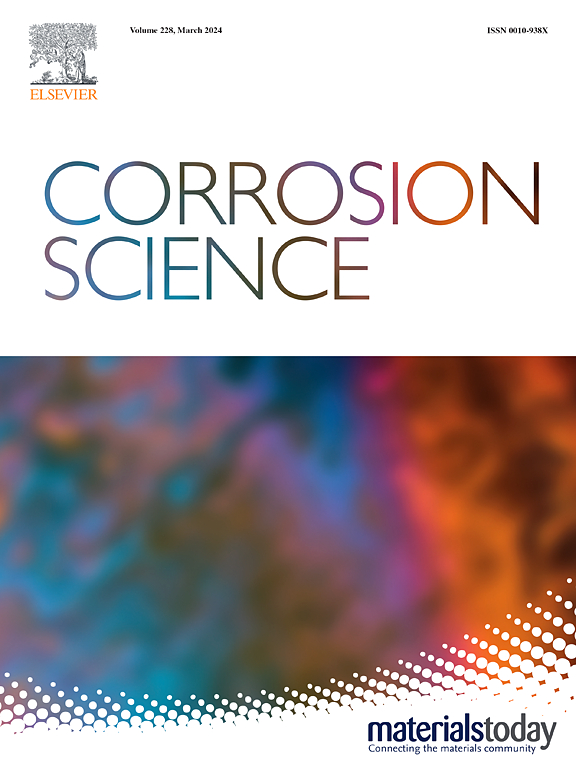The role of boron in interactions between liquid Si,B alloy and SiC at high temperature: Contribution of Raman spectroscopy, electron energy loss spectroscopy (EELS) and atom probe tomography (APT)
IF 7.4
1区 材料科学
Q1 MATERIALS SCIENCE, MULTIDISCIPLINARY
引用次数: 0
Abstract
This study examines the protective role of boron towards chemical vapor deposited (CVD) SiC via the synthesis and analysis, at various scales, of model composites representative of SiC/SiC composites prepared by silicon melt infiltration. Comparing the SiC-Si,B and SiC-Si model composites clearly demonstrates the boron's protective effect. Yet, the SiC-Si,B sample shows a macroscopic reactivity gradient related to the progression of the Si,B alloy through the porous SiC network. Electron energy loss spectroscopy (EELS) and atom probe tomography (APT) were used to assess elemental composition at the quasi-atomic and trace scales, in the different phases and at SiC/Si,B interfaces. Boron diffuses into bulk SiC, in agreement with thermodynamic calculations, but also concentrates at structural defects in polycrystalline CVD SiC. EELS and APT both revealed a high boron overconcentration over a few nanometers at SiC/Si,B interfaces, without intermediate layer visible by TEM. Raman spectroscopy also evidenced a microscale gradient of substituted boron in the Si,B alloy, near SiC/Si,B interfaces, which was related to a high carbon concentration and an unexpected carbon environment. These results led to conclude that the addition of boron cumulates three beneficial effects limiting SiC reactivity: (1) a volume effect in SiC, stabilizing and accommodating structural defects (2) an interfacial effect, with B atoms concentrating and stabilizing SiC/Si,B interfaces, and (3) a volume effect in the Si,B alloy, forming B-C clusters inhibiting carbon diffusion. Further RMS, EELS and APT analyses at different locations in the model composites would be useful to explain the macroscopic corrosion gradient.
硼在高温下液态Si、B合金和SiC相互作用中的作用:拉曼光谱、电子能量损失光谱(EELS)和原子探针层析成像(APT)的贡献
本研究通过合成和分析具有代表性的硅熔体渗透制备的SiC/SiC复合材料模型,在不同尺度上考察了硼对化学气相沉积(CVD) SiC的保护作用。通过对比SiC-Si、B和SiC-Si模型复合材料,可以清楚地看出硼的保护作用。然而,SiC-Si,B样品的宏观反应性梯度与Si,B合金在多孔碳化硅网络中的进展有关。利用电子能量损失谱(EELS)和原子探针层析成像(APT)在准原子和痕量尺度、不同相和SiC/Si,B界面上评估元素组成。与热力学计算结果一致,硼扩散到块状碳化硅中,但也集中在多晶CVD碳化硅的结构缺陷处。EELS和APT均显示,在SiC/Si,B界面上,在几纳米处存在高硼过浓,TEM看不到中间层。拉曼光谱还证实,在SiC/Si,B界面附近,Si,B合金中存在取代硼的微尺度梯度,这与高碳浓度和意想不到的碳环境有关。这些结果得出结论,硼的加入累积了三个有益的影响,限制了SiC的反应性:(1)SiC中的体积效应,稳定和容纳结构缺陷;(2)界面效应,B原子集中和稳定SiC/Si,B界面;(3)Si,B合金中的体积效应,形成B- c簇,抑制碳扩散。进一步的RMS、EELS和APT分析将有助于解释模型复合材料中不同位置的宏观腐蚀梯度。
本文章由计算机程序翻译,如有差异,请以英文原文为准。
求助全文
约1分钟内获得全文
求助全文
来源期刊

Corrosion Science
工程技术-材料科学:综合
CiteScore
13.60
自引率
18.10%
发文量
763
审稿时长
46 days
期刊介绍:
Corrosion occurrence and its practical control encompass a vast array of scientific knowledge. Corrosion Science endeavors to serve as the conduit for the exchange of ideas, developments, and research across all facets of this field, encompassing both metallic and non-metallic corrosion. The scope of this international journal is broad and inclusive. Published papers span from highly theoretical inquiries to essentially practical applications, covering diverse areas such as high-temperature oxidation, passivity, anodic oxidation, biochemical corrosion, stress corrosion cracking, and corrosion control mechanisms and methodologies.
This journal publishes original papers and critical reviews across the spectrum of pure and applied corrosion, material degradation, and surface science and engineering. It serves as a crucial link connecting metallurgists, materials scientists, and researchers investigating corrosion and degradation phenomena. Join us in advancing knowledge and understanding in the vital field of corrosion science.
 求助内容:
求助内容: 应助结果提醒方式:
应助结果提醒方式:


